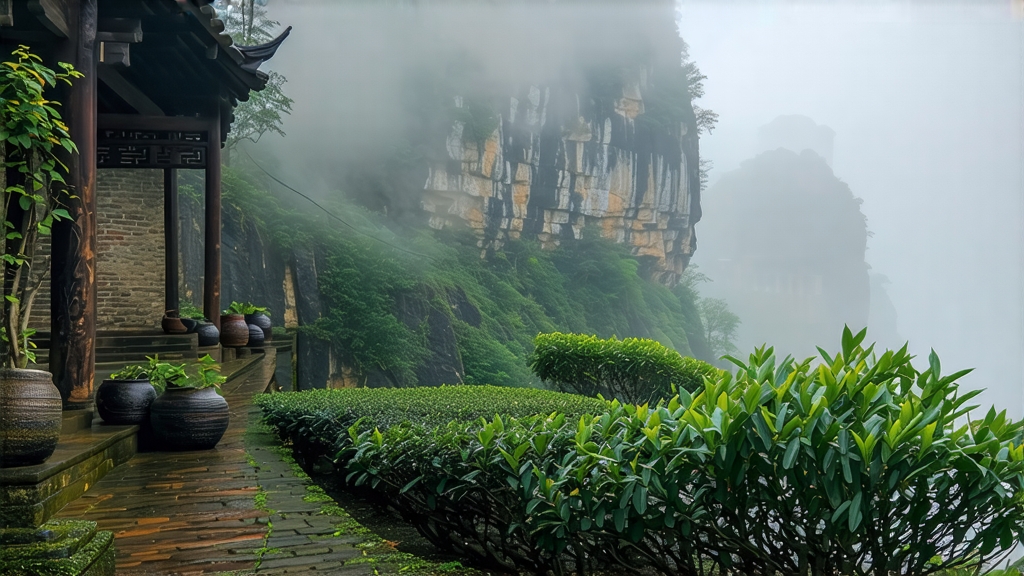
Wuyi Da Hong Pao—literally “Big Red Robe”—is the most storied sub-variety of Chinese oolong, a tea whose very name evokes imperial legend, vertical granite cliffs, and the unmistakable “rock rhyme” that connoisseurs call yan yun. To understand Da Hong Pao is to step into a 1,200-year-old marriage of geology, Taoist myth, and meticulous craft that continues to evolve inside the 60-kilometer-long Wuyi Mountain core reserve in northern Fujian Province.
-
Myth & History
Folklore says that in the early Ming dynasty a scholar on his way to the capital exams fell ill near Tianxin Temple. Monks brewed leaves picked from six ancient bushes clinging to Jiulongke (“Nine-Dragon Hollow”); the scholar revived, passed the palace exam with top honors, and returned in crimson official robes to thank the bushes. He draped his red robe over them, giving the tea its name. Whatever the truth, imperial tribute records from 1385 list “Yancha from Wuyi,” and Qing-era documents already distinguish “Da Hong Pao” as the premium grade. In 1985, cuttings from those original mother bushes—still alive but no longer harvested—were successfully propagated, creating the “pure descendant” or qidi Da Hong Pao now grown on narrow ledges throughout the Zhengyan (“true cliff”) micro-terroir. -
Terroir: Why Rocks Matter
The Wuyi range is a Danxia landform: purple-red sandstone and tuff compressed 100 million years ago, then eroded into 36 peaks and 99 valleys. Day-night temperature swings of 15 °C force slow growth, while shortwave light reflected from mineral-rich cliffs increases polyphenol and aromatic synthesis. Streams constantly fog the gullies, creating 80–90 % humidity that feeds the tea’s signature “rock bone, floral heart.” Within the 60 km² UNESCO buffer zone, only 3,000 mu (200 ha) of terraced cliff gardens carry the Zhengyan designation; soil tests show 8 % rare-element porosity and a pH of 4.5–5.0—ideal for forming the complex lignin that later translates into yan yun. -
Cultivars & Grading
Da Hong Pao is not a single plant but a stylistic label that encompasses three tiers:
a) Mother-Tree Da Hong Pao: the six 350-year-old bushes; since 2006 harvesting has been banned, making pre-ban lots cultural relics.
b) Qidi Da Hong Pao: vegetative clones (cuttings) of the mother trees, grown inside Zhengyan and genetically verified; leaf shape is oval-thick, serrated at 28–32 teeth/cm.
c) Blended Da Hong Pao: a skillful marriage of qidi with other Wuyi rock cultivars such as Tie Luo Han, Bai Ji Guan, and Shui Jin Gui to balance fragrance, body, and sweetness. Master blenders aim for “three reds and seven greens” on the infused leaf edge, indicating 30 % oxidation. -
Craft: The Eight-Stage Cliff Ballet
Plucking happens only in late April when three half-open leaves constitute one “open face.” From bush to finished tea, eight steps unfold within 24 hours: -
Picking—only between 9 a.m. and 11 a.m. when surface dew has evaporated.
-
Sun-withering—leaves are spread 2 cm thick on bamboo screens tilted toward the southeast sun for 20 minutes; UV triggers grassy hexenal conversion.
-
Indoor withering—moved onto water-heat pipes inside the “qing jian” room; 18 °C and 75 % RH for 2–3 hours with gentle turning every 30 minutes.
-
Yaoqing—“rocking” in bamboo drums 8–12 times; edge bruising starts oxidation while veins remain green.
-
Sha Qing—kill-green at 240 °C for 7 minutes in a leveled wok; enzymes deactivated but leaf structure kept pliable.
-
Rolling—60 kg batches are machine-rolled for 12 minutes under 55 kg pressure to rupture 35 % of cells, releasing catechins for later polymerization.
-
Roasting—